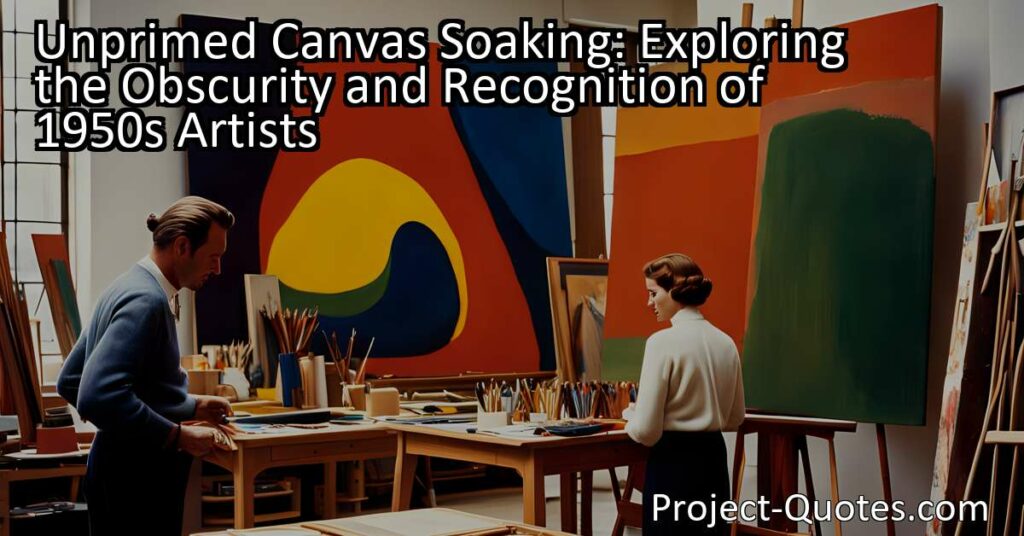In the ’50s Morris Louis and I were not known, David Smith and Helen Frankenthaler were not much known.
Kenneth Noland
Unprimed Canvas Soaking: The Groundbreaking Technique that Shaped 1950s Art Discover how artists like Helen Frankenthaler revolutionized the art world with their technique of pouring and soaking paint onto unprimed canvas in the 1950s. This “soak-stain” method resulted in mesmerizing compositions and left a lasting impact on the trajectory of modern art. Learn how these artists, once relatively unknown, ultimately achieved recognition and became influential figures in art history.
Table of Contents
Meaning of Quote – In the ’50s Morris Louis and I were not known, David Smith and Helen Frankenthaler were not much known.
In the vibrant art world of the 1950s, a number of talented artists were slowly gaining recognition for their unique styles and contributions to the art scene. However, among this group of artists, there were a few individuals who were relatively unknown at the time. In particular, Kenneth Noland refers to Morris Louis, David Smith, and Helen Frankenthaler, as artists who were not widely known during this period. Yet, as time would unfold and artistic legacies would be written, these artists would ultimately leave their mark on the art world, earning their rightful place in the annals of art history.
One such artist, Morris Louis, was an American painter who spearheaded the color field movement alongside his contemporary and close friend, Kenneth Noland. Color field painting, a style that emphasized large areas of flat color, dominated the art scene during the 1950s and 1960s. Although initially not well-known, Louis would go on to become one of the prominent figures associated with this movement. His unique approach to color and form, characterized by vibrant and saturated hues, created a sense of expansiveness and pure visual pleasure.
David Smith, on the other hand, was known for his pioneering sculptures. He revolutionized the concept of three-dimensional artworks by incorporating welded metal and found objects into his creations. Smith’s sculptures were bold and innovative, and his unique artistic vision propelled him to the forefront of the contemporary art scene. Despite not being widely recognized in the 1950s, his influence on subsequent generations of sculptors is significant and cannot be overlooked.
Additionally, Helen Frankenthaler, a prominent American abstract expressionist painter, played a crucial role in shaping the trajectory of modern art. Frankenthaler’s technique of pouring and soaking paint onto unprimed canvas, known as the “soak-stain” method, allowed colors to blend and merge, resulting in organic and ethereal compositions. Although she may not have been as recognized as some of her male counterparts during the ’50s, her groundbreaking approach to abstraction left an indelible mark and inspired countless future artists.
Noland’s acknowledgment of these artists, including himself, as being relatively unknown during that era raises an interesting point about artistic recognition and fame. The art world is not always a fair and equitable landscape where talent is immediately recognized. It is often a fluctuating and subjective realm, where some artists take longer to gain widespread acclaim, while others receive immediate recognition.
However, Noland’s observation also highlights the fluid nature of the art world and the potential for artists to achieve recognition and acclaim long after their initial contributions. The ’50s may have been a transitional period for art, with the dominance of abstract expressionism paving the way for color field painting and other innovative styles. During this time, artists like Noland, Louis, Smith, and Frankenthaler were quietly pushing boundaries and experimenting with new artistic approaches, unknowingly shaping the future of art.
In retrospect, it is fascinating to witness the trajectory of these artists’ careers and the impact they ultimately had on the broader art world. Their works have not only stood the test of time but have also inspired subsequent generations of artists to push the boundaries of their own creativity.
Moreover, Noland’s quote sheds light on the concept of recognition, suggesting that the notion of fame should not be the ultimate goal for an artist. Creating art should be driven by passion, personal expression, and a desire to contribute something meaningful to the artistic discourse. Whether an artist achieves widespread recognition or not, the act of creation itself is often a fulfilling and transformative process.
It is worth noting that artistic recognition is complex and multifaceted. It depends on numerous factors including socio-political climate, art movements, personal connections, and sheer luck. While it is essential to acknowledge the contributions of influential figures like Morris Louis, David Smith, and Helen Frankenthaler, it is equally important to recognize the countless other artists who may have been overlooked during their time but still made valuable contributions to the art world.
In conclusion, Kenneth Noland’s insightful quote about the relative obscurity of artists like Morris Louis, David Smith, and Helen Frankenthaler in the 1950s reminds us of the ever-changing nature of artistic recognition. These artists, along with Noland himself, would ultimately carve their place in history through their groundbreaking approaches and unwavering dedication. Their stories are a testament to the power of perseverance, creativity, and the enduring impact of art on our culture and society.
I hope this quote inspired image brings you hope and peace. Share it with someone who needs it today!


